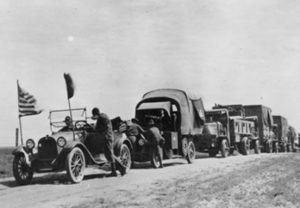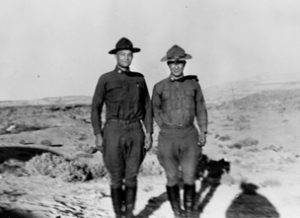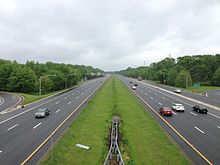interstate highway

 Have you ever wondered how the Interstate road system got started? People didn’t just wake up one day and envision a great system of roads that could transport us from one side of the country to the other. There had to be some reasons to do such a thing, right? Well, there was. In 1919, Dwight Eisenhower was feeling a bit disenchanted with life, because his wife and infant son were living 1,500 miles away in Denver, while he was a 28 year old lieutenant colonel stationed at Maryland’s Camp Meade. He was bored and miserable, and so he and his fellow soldiers wasted the hours playing bridge and complaining about being kept stateside during World War I. What do people do when they need to break through the boredom…what else, a road trip!!
Have you ever wondered how the Interstate road system got started? People didn’t just wake up one day and envision a great system of roads that could transport us from one side of the country to the other. There had to be some reasons to do such a thing, right? Well, there was. In 1919, Dwight Eisenhower was feeling a bit disenchanted with life, because his wife and infant son were living 1,500 miles away in Denver, while he was a 28 year old lieutenant colonel stationed at Maryland’s Camp Meade. He was bored and miserable, and so he and his fellow soldiers wasted the hours playing bridge and complaining about being kept stateside during World War I. What do people do when they need to break through the boredom…what else, a road trip!!
Eisenhower heard that two volunteer tank officers from Camp Meade were needed to participate in a coast to coast military convoy to San Francisco. It was the perfect adventure, so Eisenhower immediately volunteered his services. Granted, it wasn’t the thrill of battle that the young soldier had planned to spend his time in the service engaging in, but it was far better than playing bridge. Little did he know just how grueling the trip would be. Remember that these were the early years of the automobile, and drivers were just as likely to encounter roads to nowhere, as they were the open road. Highways were not usually paved. Dirt roads could be a muddy mess or so dry that they were either dust clouds or full of ruts. Sixty miles an hour was unheard of and many roads could only be driven at the pace of a brisk walk. As a means of transporting military equipment quickly from one coast to the other…this system left much to be desired, in fact it was a miserable excuse for a road system at all. Something had to change.
Fast forward a few years…37 years to be exact, and you will find then President Dwight D Eisenhower signing the Federal-Aid Highway Act of 1956 privately, without ceremony, on June 29, 1956. The system would take decades to build, and in reality is always under construction. The project was the largest public works project in American history. The project would pour billions of dollars into the nation’s economy all over the country, putting many people to work. Today, it continues to be a boon to the economy because of the maintenance and repairs needed to keep it going.
In 1990, as a tribute to Eisenhower, on the centennial of his birth, President George H W Bush redesignated the 
 interstate system as the Dwight D Eisenhower National System of Interstate and Defense Highways. Interstate 80, would be quite familiar to Eisenhower. It starts just across the Hudson River from New York City, then goes through New Jersey and Pennsylvania, and into Ohio, where it follows generally the route of the 1919 Army convoy to San Francisco that had sparked Eisenhower’s interest in such a system in the first place.
interstate system as the Dwight D Eisenhower National System of Interstate and Defense Highways. Interstate 80, would be quite familiar to Eisenhower. It starts just across the Hudson River from New York City, then goes through New Jersey and Pennsylvania, and into Ohio, where it follows generally the route of the 1919 Army convoy to San Francisco that had sparked Eisenhower’s interest in such a system in the first place.

